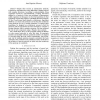Free Online Productivity Tools
i2Speak
i2Symbol
i2OCR
iTex2Img
iWeb2Print
iWeb2Shot
i2Type
iPdf2Split
iPdf2Merge
i2Bopomofo
i2Arabic
i2Style
i2Image
i2PDF
iLatex2Rtf
Sci2ools
CEC
2009
IEEE
2009
IEEE
Evolving modular neural-networks through exaptation
— Despite their success as optimization methods, evolutionary algorithms face many difficulties to design artifacts with complex structures. According to paleontologists, living organisms evolved by opportunistically co-opting characters adapted to a function to solve new problems, a phenomenon called exaptation. In this paper, we draw the hypotheses (1) that exaptation requires the presence of multiple selection pressures, (2) that Pareto-based multi-objective evolutionary algorithms (MOEA) can create such pressures and (3) that the modularity of the genotype is a key to enable exaptation. To explore these hypotheses, we designed an evolutionary process to find the structure and the parameters of neural networks to compute a Boolean function with a modular structure. We then analyzed the role of each component using a Shapley value analysis. Our results show that: (1) the proposed method is efficient to evolve neural networks to solve this task; (2) genotypic modules and multiple...
Artificial Intelligence | CEC 2009 | Evolutionary Algorithms | Multiple Selection Pressures | Neural Networks |
| Added | 20 May 2010 |
| Updated | 20 May 2010 |
| Type | Conference |
| Year | 2009 |
| Where | CEC |
| Authors | Jean-Baptiste Mouret, Stéphane Doncieux |
Comments (0)

